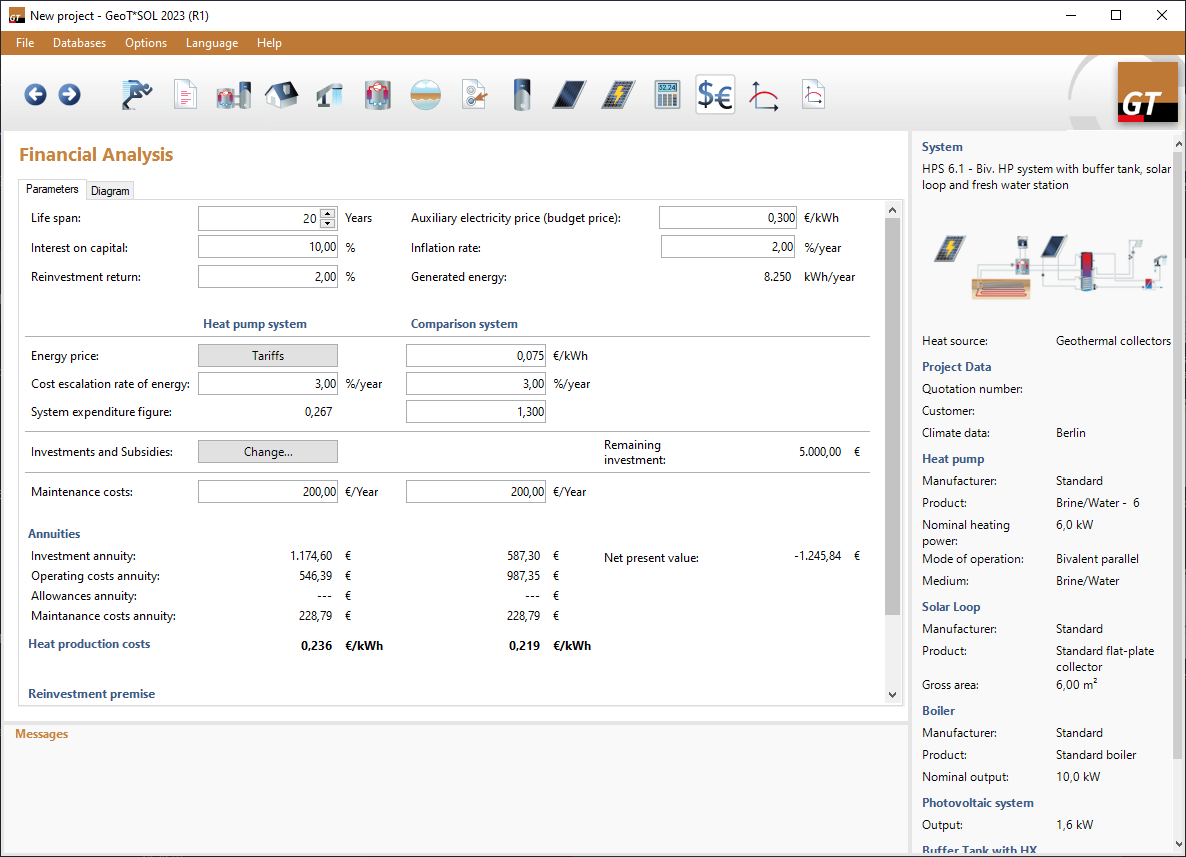The profitability and heating price of your heat pump system are calculated here. The calculation of the heating prices and the system expenditure figures are based on the sum of the generated energies displayed on the previous page (simulation results){.GUII-Seite} (heat pump + heating element + solar system).
Enter the following parameters:
-
Life span of the heat pump system (The period of time stated by the manufacturer in which the system is expected to remain operational. Between 10 and 20 years is estimated for heat pump systems.)
-
Interest on capital (The interest on capital is the interest rate at which capital for the investment would have to be borrowed from a bank or the rate at which the invested capital could bear interest.)
-
Reinvestment return The reinvestment return is used under the so-called reinvestment premise (see below). Investment surpluses (=pos. cash flows) earn interest and are compounded with this rate.
-
Auxiliary electricity price
-
Inflation rate (price increase) (The development of operating and fuel costs is of key importance for the actual cash value.)
-
The generated energy is calculated by the simulation.
For the financing, enter values for both heat pump system and comparison system:
-
Energy price (select a tariff)
-
Cost escalation rate of energy (Inflation rate energy)
-
The System expenditure figure is the relationship of expenditures and benefits. The benefits here are the sum of the generated energies (heat pump + heating element + solar system) which has to be delivered by the comparison system too. The expenditure of the comparison system is, for a gas boiler as an example, the gas consumption. For the heat pump system, the system expenditure figure is the reciprocal value of the Seasonal Performance Factor of the heat pump system (incl. solar system).
-
Investments and Subsidies: Click on Change to enter the details in the dialog Investments and Subsidies. You can specify investments (total), subsidy, allowances, and delivered energy for the heat pump system, the corresponding solar thermal system, and a comparison system. The allowances can be used to enter regular payments by adjusting the payment amount and the payment duration according to your respective subsidy scheme. If your subsidy scheme sets a maximum to the possible amount of subsidized energy, use the option
 User-defined, in order
to enter the maximum delivered energy.
User-defined, in order
to enter the maximum delivered energy.The remaining investment is the difference of the investments (minus subsidies) of the heat pump system and the comparison system.
-
Maintenance costs
Based on this data and the information regarding the heat pump and auxiliary energy consumers, the following calculations are performed:
-
Annuities Investment annuity, operating costs annuity, allowances annuity, maintenance costs annuity, and net present value.
-
Heating price Using the heating price, the heat pump can be compared with other heating systems (e.g., with a gas- or oil-fired boiler) to assist the property owner when making an investment decision. For the heating price, the investment less the subsidy and the operating and maintenance costs via annuities (lifetime, simple interest) are apportioned to the heat yield.
-
Reinvestment premise Modified internal rate of return (MIRR) is used to compare the heat pump system with the same amount of money if it would have been deposited in a bank account: The MIRR is a return (a.k.a. interest rate), which the bank account must reach to reach the same end balance. As an owner/user, one can see this as follows: If the bank pays an interest rate (reinvestment return, RI) that is less than the MIRR, the investment then earns a higher end balance. The MIRR is the return that the heat pump system achieves. For an economic investment, RI < MIRR must apply.
The [Net Present Value* is the difference of the respective net present values of the heat pump and the comparison systems. The Net Present Value is the total of the respective present values. The accumulated cashflow with the reinvestment return is called [Balance*. Positive cash flows can be seen as savings and can be paid into a bank account. After the life span, the end balance will be reached.
The Surplus is the difference of the end balance and the remaining investment.
 Proceed to the next page.
Proceed to the next page.
